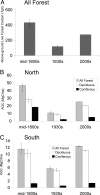Historical forest baselines reveal potential for continued carbon sequestration
- PMID: 19369213
- PMCID: PMC2669390
- DOI: 10.1073/pnas.0810076106
Historical forest baselines reveal potential for continued carbon sequestration
Abstract
One-third of net CO(2) emissions to the atmosphere since 1850 are the result of land-use change, primarily from the clearing of forests for timber and agriculture, but quantifying these changes is complicated by the lack of historical data on both former ecosystem conditions and the extent and spatial configuration of subsequent land use. Using fine-resolution historical survey records, we reconstruct pre-EuroAmerican settlement (1850s) forest carbon in the state of Wisconsin, examine changes in carbon after logging and agricultural conversion, and assess the potential for future sequestration through forest recovery. Results suggest that total above-ground live forest carbon (AGC) fell from 434 TgC before settlement to 120 TgC at the peak of agricultural clearing in the 1930s and has since recovered to approximately 276 TgC. The spatial distribution of AGC, however, has shifted significantly. Former savanna ecosystems in the south now store more AGC because of fire suppression and forest ingrowth, despite the fact that most of the region remains in agriculture, whereas northern forests still store much less carbon than before settlement. Across the state, continued sequestration in existing forests has the potential to contribute an additional 69 TgC. Reforestation of agricultural lands, in particular, the formerly high C-density forests in the north-central region that are now agricultural lands less optimal than those in the south, could contribute 150 TgC. Restoring historical carbon stocks across the landscape will therefore require reassessing overall land-use choices, but a range of options can be ranked and considered under changing needs for ecosystem services.
Conflict of interest statement
The authors declare no conflict of interest.
Figures




References
-
- Houghton RA. The annual net flux of carbon to the atmosphere from changes in land use 1850–1990. Tellus. 1999;51B:298–313.
-
- Ramankutty N, et al. Challenges to estimating carbon emissions from tropical deforestation. Glob Change Biol. 2007;13:51–66.
-
- Dixon RK, et al. Carbon pools and flux of global forest ecosystems. Science. 1994;263:185–190. - PubMed
-
- Clawson M. Forests in the long sweep of American history. Science. 1979;204:1168–1174. - PubMed
-
- Foster DR, Motzkin G, Slater B. Land-use history as long-term broad-scale disturbance: Regional forest dynamics in Central New England. Ecosystems. 1998;1:96–119.
Publication types
MeSH terms
Substances
LinkOut - more resources
Full Text Sources
Other Literature Sources

